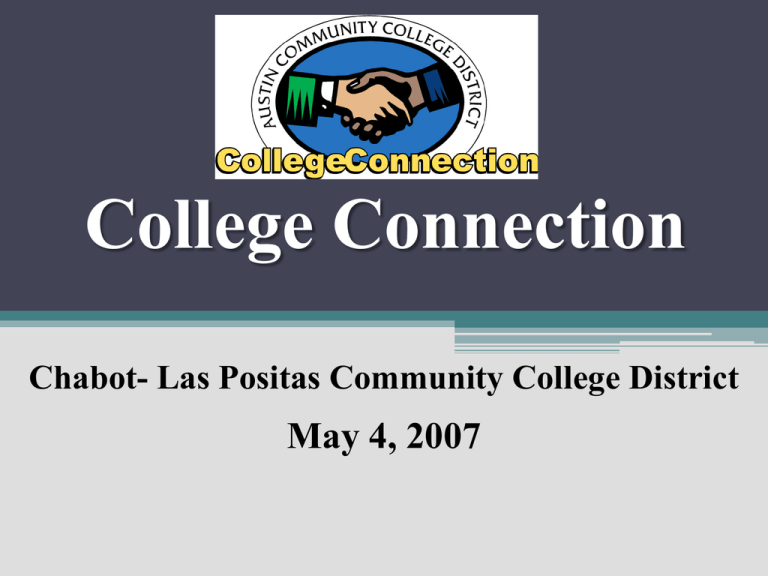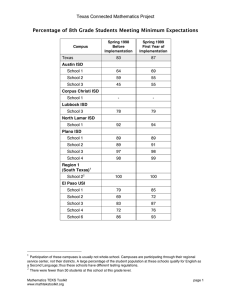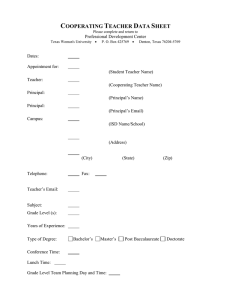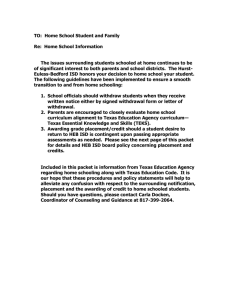College Connection May 4, 2007 Chabot- Las Positas Community College District
advertisement

College Connection Chabot- Las Positas Community College District May 4, 2007 Presenters Presenters Mary Hensley, Ed.D. Vice President, College Support Systems and ISD Relations mhensley@austincc.edu 512-223-7618 Luanne Preston, Ph.D. Executive Director, Early College Start and College Connection luanne@austincc.edu 512-223-7354 Agenda • Closing the Gaps Overview • College Connection Overview • College Connection How It Works • Program Results • Program Recognition • State and National Interest in Expansion • College Connection How To Start • Questions and Answers Texas Higher Education Coordinating Board’s Strategic Plan “Closing the Gaps” Overview Closing the Gaps in Participation • Closing the Gaps warns that if more Texans do not receive college degrees by 2030, the State could lose up to $40 billion in annual household income. • The goal is to increase student enrollment in higher education by 630,000 by 2015. • Most students will elect to start at a community college. • Austin Community College District expects 15,000 more students by 2015. College Connection Overview Education Beyond High School Increases earning potential and employment opportunities U.S. Department of Education Learn to Earn a eC oll eg e As so cia te Ba ch elo r's M as te r s Ph .D Pr . of ess ion al om So m Di pl HS Le ss t ha nH S 90000 80000 70000 60000 50000 40000 30000 20000 10000 0 Source: Postsecondary Education OPPORTUNITY Excuses For Not Continuing Your Education No one in my family has ever gone to college. I’ve been in school for 12 years. That’s enough! I just want a good job. I can’t afford it. I don’t know what I want to do with my life. College is too hard. I won’t fit in. I don’t know how to apply or where I want to go. Source: Adapted from The College Board’s “Seven Excuses Not to Go to College and Why They’re Lame” Improving High School to College Transitions • Provide admission and pre-enrollment services to seniors on their school campuses • Create an expectation that “College is in everyone’s future.” • Increase percentage of high school seniors who enter college after high school graduation. Austin Community College District Service Area College Transition Rates Texas High School Graduates from FY 2006 Enrolled in Texas Higher Education Fall 2006 School District Austin Total High School Graduates Students Enrolled in Texas Universities Students Enrolled in Texas 2-year Colleges Students Not Located in Texas Higher Education * 3,856 1,111 29% 737 19% 2,008 52% Bastrop 460 105 23% 73 16% 282 61% Blanco 76 36 47% 13 17% 27 36% 319 32 10% 58 18% 229 72% Dripping Springs 240 95 40% 62 26% 83 35% Eanes 555 280 50% 59 11% 216 39% Elgin 169 45 27% 29 17% 95 56% Fredericksburg 227 88 39% 33 15% 106 47% Coupland** Del Valle Doss** *Includes students who were not enrolled in Texas colleges or universities in the year immediately following graduation, as well as students who were enrolled out-of-state. **Districts with less than 25 graduates are not included in this report. Source: http://www.thecb.state.tx.us/Reports/PDF/1161.PDF Austin Community College District Service Area College Transition Rates Texas High School Graduates from FY 2006 Enrolled in Texas Higher Education Fall 2006 School District Georgetown Total High School Graduates Students Enrolled in Texas Universities Students Enrolled in Texas 2-year Colleges Students Not Located in Texas Higher Education * 519 214 41% 98 19% 207 40% 46 29 63% 3 7% 14 30% Hays 559 177 32% 96 17% 286 51% Jarrell 44 14 32% 8 18% 22 50% Johnson City 45 16 36% 6 13% 23 51% Lago Vista 73 32 44% 21 29% 20 27% Lake Travis 318 144 45% 62 19% 112 35% 1,052 371 35% 263 25% 418 40% Liberty Hill 120 46 38% 24 20% 50 42% Lockhart 219 62 28% 36 16% 121 55% Harper Leander *Includes students who were not enrolled in Texas colleges or universities in the year immediately following graduation, as well as students who were enrolled out-of-state. **Districts with less than 25 graduates are not included in this report. Source: http://www.thecb.state.tx.us/Reports/PDF/1161.PDF Austin Community College District Service Area College Transition Rates Texas High School Graduates from FY 2006 Enrolled in Texas Higher Education Fall 2006 School District Total High School Graduates Students Enrolled in Texas Universities Students Enrolled in Texas 2-year Colleges Students Not Located in Texas Higher Education * Luling 87 24 28% 9 10% 54 62% Manor 131 26 20% 16 12% 89 68% 65 12 18% 9 14% 44 68% 964 319 33% 234 24% 411 43% Round Rock 2,158 765 35% 373 17% 1,020 47% San Marcos 448 98 22% 56 13% 294 66% Smithville 125 31 25% 28 22% 66 53% Wimberley 146 44 30% 45 31% 57 39% McDade** Nixon Smiley Pflugerville Prairie Lea** Total 13,021 4,216 32% 2,451 19% 6,354 49% *Includes students who were not enrolled in Texas colleges or universities in the year immediately following graduation, as well as students who were enrolled out-of-state. **Districts with less than 25 graduates are not included in this report. Source: http://www.thecb.state.tx.us/Reports/PDF/1161.PDF College Connection How It Works College Connection Program • Many high school students find the college enrollment process intimidating. • Austin Community College District provides handson, one-on-one support to assist every student through each step of the college admissions process. • During graduation ceremonies, high school graduating seniors receive acceptance letters to Austin Community College District. Students Receive Services at the High School: Required • • • • • Admission application ASSET or COMPASS Pre-advising Academic advising Graduation letter Recommended • Senior presentation • Financial aid application Optional • • • • • Student life info Teleconference Campus tours Registration Other College Connection Activity Grid Sample District Lead: San Marcos HS Lead: Sylvia Garza, 512-393-6742, sylvia.garza@smcisd.net Chad Kelly, 512-393-6800, chad.kelly@smcisd.net Admin. Assistant: Lisa Jordan, 512-393-6805, lisa.jordan@smcisd.net ACC Lead: Mary Hensley, 223-7618, mhensley@austincc.edu/Luanne Preston, 223-7355, luanne@austincc.edu Exec. Assistant: Esther Buzard, 223-7618, ebuzard@austincc.edu College Connection Lead: Luanne Preston, 223-7354, luanne@austincc.edu Admin. Assistant: Laurie Clark, 223-7354, lclark2@austincc.edu Senior Count:424 (SMHS) Activity Date Signature Letter of Release August 30, 2006 Senior Assembly September 8, 2006 Admissions Application October 3, 2006 Make-Up Day October 6, 2006 ASSET Assessment (paper and pencil) Financial Aid Time Location Equipment Communication San Marcos HS Contact (*Lead Contact) firstname.lastname@sm cisd.net ACC District Contact (*Lead Contact) name@austincc.edu Template letter •Letters to parents contest *Cecily Moore cecily.moore *Luanne Preston luanne 9:45-11:15 a.m. SMHS Auditorium and Library •Notice in parent newsletter •Notice on high school website *Chad Kelly chad.kelly *K. Leigh Forell khammfor 8:20 a.m. – 3:55 p.m. Library computer labs/ English classes •Non-citizen students must obtain alternate ID before completeing application *Mary Williams mary.williams *Linda Kluck lkluck February 6 & 8, 2007 8:20 a.m. – 3:55 p.m. Room A123; Library •Schedule to parents & on web site *Mary Williams mary.williams *Holly Delacroix hdelacro April 12, 2007 8:20 a.m. – 3:55 p.m. Library Information sheet disseminated to students @ school & via web site *Cecily Moore cecily.moore *Gail Braswell gbraswell SHADE/BOLD – Required College Connection Activities Lifetime Acceptance • Application never discarded • Provide a permanent college home • Students come to ACC District ▫ ▫ ▫ ▫ In summer for transfer After military service After career changes Co-enroll while attending 4-year institution • Cohorts can be tracked by semester of entry; ACC District collects longitudinal data for retention, completion and success Program Results College Connection School Districts 2003-04 (Year 1) 2004-05 (Year 2) 2005-06 (Year 3) 2006-07 (Year 4) San Marcos Austin Austin Bastrop Bastrop Del Valle Del Valle Leander Hays San Marcos Leander Austin Bastrop Blanco Del Valle Elgin Fredericksburg Harper Hays Jarrell Johnson City Lago Vista Leander Liberty Hill Lockhart Luling Manor Nixon-Smiley Pflugerville Prairie Lea Round Rock San Marcos Smithville Manor Pflugerville San Marcos School Districts Participating in the College Connection Program 2006-2007 School District Number of High Schools Number of Seniors Year Started Austin ISD 12 4,200 2004 Bastrop ISD 1 560 2004 Blanco ISD 1 77 2006 Del Valle ISD 2 367 2004 Elgin ISD 2 234 2006 Fredericksburg ISD 1 236 2006 Harper ISD 1 33 2006 Hays CISD 3 665 2005 Jarrell ISD 1 60 2006 Johnson City ISD 1 49 2006 Lago Vista ISD 1 89 2006 Leander ISD 4 1,386 2004 School Districts Participating in the College Connection Program 2006-2007 School District Number of High Schools Number of Seniors Year Started Liberty Hill ISD 1 138 2006 Lockhart ISD 2 376 2006 Luling ISD 1 124 2006 Manor ISD 2 226 2005 Nixon-Smiley CISD 1 73 2006 Pflugerville ISD 2 436 2005 Prairie Lea ISD 1 20 2006 Round Rock ISD 5 2,597 2006 San Marcos CISD 2 484 2003 Smithville ISD 1 115 2006 48 12,545 Total (22) College Connection Program Growth Over 3 years: • 1 school district to 22 school districts • 2 high schools to 48 high schools • 400 students to 12,000+ students ACC District’s Future Goal: • Include all 30 school districts in service area The College Connection Program Works! Students NOT located in Texas Higher Education Fall 2003 ISD Number San Marcos Austin Bastrop Del Valle Leander Hays Manor Pflugerville 273 2,155 286 293 444 281 51 194 Students NOT located in Texas Higher Education Fall 2004 Percent Number 66% 56% 69% 77% 48% 57% 57% 47% 219 2,066 234 312 459 309 74 201 Students NOT located in Texas Higher Education Fall 2005 Percent Number 55% 56% 57% 80% 48% 56% 57% 47% 234 2,005 239 236 422 290 87 204 Students NOT located in Texas Higher Education Fall 2006 Percent Number 59% 54% 54% 66% 42% 55% 62% 48% Blue=Year College Connection started 1-Source: http://www.txhighereddata.org/Reports/PDF/0961.pdf 2-Source: http://www.txhighereddata.org/Reports/PDF/0963.pdf 3-Source: http://www.thecb.state.tx.us/Reports/PDF/1161.PDF 294 2,014 282 229 418 286 89 156 2006 Increase of Students in Higher Ed Since Implementation Percent 66% 52% 61% 71% 40% 51% 68% 46% 0% 4% -4 % 9% 8% 5% -6 % 2% College Connection Diversity of Participants ▫ ▫ ▫ ▫ ▫ Anglo African American Hispanic Asian Other 41% 11% 39% 4% 5% Traditionally Underrepresented in Higher Education - Students Enroll at ACC District • More than 55% of College Connection enrollees are minorities • Higher percentage entering ACC District through College Connection than in the general ACC District student population College Connection Results for ACC District, 2004-2006 • Positive effect on fall enrollments ▫ Immediate great results: 37.6% increase first year ▫ 59% increase over two years • Positive effect on Early College Start enrollments ▫ 25.6% increase in enrollment from ‘04 to ’05 ▫ 45% increase in enrollment from ’04 to ’06 • Positive effect on Tech Prep enrollments ▫ 714% increase in number of students receiving Tech Prep credit 36 students in 2003-04 48 students in 2004-05 293 students in 2005-06 Program Recognition College Connection Program National Acclaim & Recognition Awards Received • THECB Star Award • Excelencia in Education Award Award Recipient November 2006 • Bellwether Award Semi-Finalist October 2006 Award Recipient January 2007 State and National Interest in Expansion “Attaining advanced levels of education for disadvantaged students cannot be done without developing a college-going culture in every middle school and high school in the state of Texas...then suddenly, (going to college) changes from being a possibility to an expectation.” --Raymund Paredes Commissioner, Texas Higher Education Coordinating Board January 6, 2005 State Interest: • 6 Texas community colleges adopt College Connection Program • 4 Texas community colleges express interest • Texas Higher Education Coordinating Board to expand program statewide beginning Fall 2007 National Interest: Florida Department of Education • Launched state-wide campaign in April 2007 called “Go Higher-Get Accepted” modeled after College Connection Maine Interest in College Connection • Proposed law requiring graduating high school seniors to complete at least one college application before getting diploma. • Support from “Compact for Higher Education” External Support • Funding to Expand College Connection • Funding for Mobile Go Center Mobile Go Center Related Initiatives • Mini-College Connection for Adult Education • College Connection Scholarships College Connection: How To Start Collaborate with School Partners • Find higher education transition rates for local high schools • Use other partnerships (dual credit, tech prep, etc.) as a springboard • Choose a pilot school or group of schools • Meet with superintendent to discuss: ▫ ▫ ▫ ▫ ▫ ▫ program features advantages to students and district transition rates formal agreement buy-in from district campus staff Formal Agreement • Between college and school district • Signed by chancellor, president, and superintendent • Establishes transfer of student data from high school to college • Details responsibilities and expectations Advance Briefing • District/Central Office Staff • High School Principal Planning Meeting • One meeting held annually • Early Summer, before high school staff leave is ideal • Complete activity grid • Should take about one hour (slightly longer for new schools or multiple schools) • Stick to scheduling; work out details between designated contact for each activity Planning Meeting Recommended Participants: College • District lead person • Implementation lead person • Team leader for services ▫ Admissions representative ▫ Financial Aid representative ▫ Assessment representative ▫ Recruitment representative ▫ Advising representative ▫ Recorder High School • • • • Principal Grade level principal or AP Lead or senior counselor Person in charge of testing/scheduling • Tech person (use of computer labs) • Any staff that works with the “senior class” • Bring ▫ Bell schedule ▫ School calendar ▫ A/B Block scheduling ▫ Testing calendar Data Collection • Collect electronically (EXCEL) • Mark records as College Connection cohort • Collect from high school ▫ ▫ ▫ ▫ ▫ Name Address DOB HS Student ID (for later record matching) Test Scores (HS Exit Exam, SAT, ACT) Communications • Electronic via list serv • Updated activity grid sent via e-mail when changes occur • College Connection Website • iCal ▫ Combined calendar for internal use Data Follow-Up • Track by school, how many students complete each activity • Plan multiple visits to get 100% participation • Give high school principal participation rates for use at graduation announcement ceremony • Report Fall enrollment from pilot schools (compare to benchmark), spring persistence Website • Participating schools • Links to school pages • Link to college pages of interest • Press coverage/special events Austin Community College College Connection Website www.austincc.edu/isd • Access to scheduled activities for students, parents, and school officials • Calendars • Links to pertinent ACC school district sites Helpful Hints • Know/connect with Superintendent(s) in School District(s) • Form a College/ISD planning team • Form a College/High School planning team • Initially use a core team of early adopters • Build support for program within CLPCCD • Understand K-12 operations • Begin with a smaller school district • Small and successful=Others will come Helpful Hints • College departments such as Information Technology, Public Relations, Dual Credit, Tech Prep, Foundation, and particularly, Student Recruitment and Student Services, must be supportive • Do away with thinking that students “have to come to the college” to meet college processes • Focus on what works for the school district • Make it a “win-win” program for both Helpful Hints • Use publicity and press conferences at every opportunity • Get Foundation involved in raising scholarships • Make a presentation to each school district Board • Use current staff to serve on teams • Expand personnel requests through budget process/master plan process Helpful Hints • Keep CLPCCD Board involved • Continually thank and recognize participants • Involve staff in recognitions • Keep College Connection process simple • Understand what is/is not required • Time/effort now will reduce work later Helpful Hints • Increased enrollments will build programs and support staff • Many “off shoots” develop: ▫ ▫ ▫ ▫ ▫ ▫ ▫ ▫ ▫ ▫ ▫ Chamber of Commerce events/support Grants and Contracts Annexation Scholarships Continuing education Training Teacher certification Instructional Aide Training Dual Credit Tech Prep Other Helpful Hints • Name a single point-of-contact for all communications • Utilize technology for communication including web, listserv, and online calendars (I-Cal) • Build a superintendents’ e-mail list • Have joint CLPCC and School District Board meetings • Form CLPCCD/ISD Executive Team • Provide immediate response/service • Pace for success • Initially use key leaders on teams then expand to lower-level personnel For copies: PowerPoint Presentation: www.austincc.edu/isd/las_positas/050407Presenta tion.ppt Handouts: www.austincc.edu/isd/documents Questions and Answers



